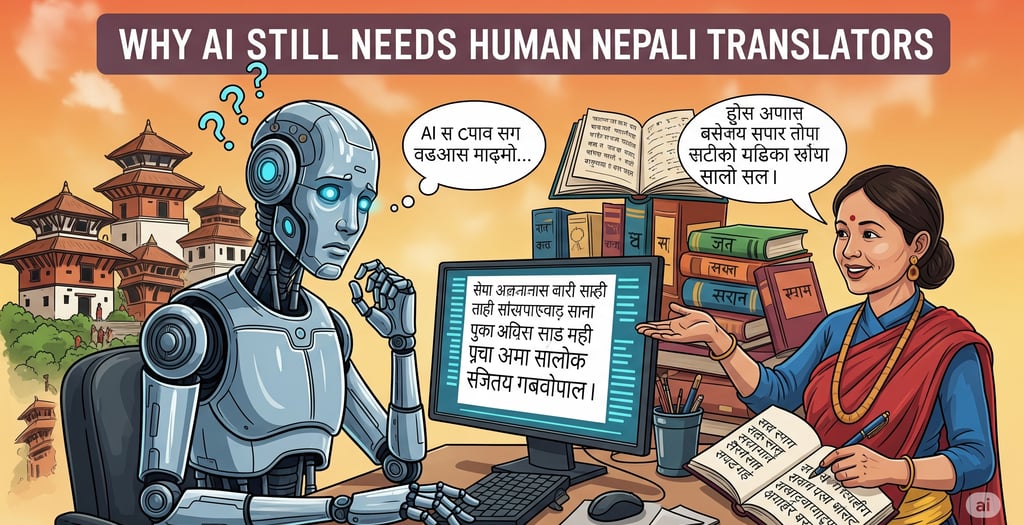Why AI Still Needs Human Nepali Translators
Discover why Artificial Intelligence (AI) is not yet ready to fully replace human Nepali translators. This insightful blog explores the limitations of machine translation, the importance of cultural and contextual accuracy, and the irreplaceable value of native-language experts in delivering high-quality, professional English to Nepali translations.


As artificial intelligence (AI) continues to transform the language industry, machine translation (MT) tools like Google Translate and DeepL have become more sophisticated than ever. These tools offer fast, cost-effective translations across many language pairs, including English to Nepali. However, while the speed and automation of AI are impressive, they still fall short when it comes to capturing the nuances, cultural context, and accuracy that only a human Nepali translator can deliver.
In this blog, we’ll explore the core reasons why AI still relies heavily on human translators—especially in a language as complex and culturally rich as Nepali.
1. Nepali Language Complexity
Nepali is a morphologically rich language with a flexible sentence structure and context-dependent meanings. A single word can change meaning based on formality level, gender, or region. While AI systems are trained on massive datasets, they still struggle with:
Honorifics and formality levels
Contextual usage of words like "तपाईं" vs. "तँ"
Translating compound verbs and idiomatic expressions
Accurate syntax in complex legal, financial, or literary documents
Human translators instinctively understand these subtleties—something no algorithm can truly replicate without enormous manual tuning and localized training data.
2. Cultural and Contextual Understanding
Translation is not just about converting words; it’s about communicating the same message across cultures. This becomes especially important in sectors like marketing, health, education, and government communication. AI often produces literal translations that miss the cultural tone, humor, or intent behind a sentence.
For example, translating a campaign slogan or a public health message requires more than linguistic accuracy—it requires local insight. Human Nepali translators adapt the message so it feels natural and impactful to the target audience.
3. Limitations in Specialized Domains
In legal, medical, and technical fields, even minor translation errors can have serious consequences. While AI might give a rough idea of the content, it lacks the domain expertise and critical thinking needed to ensure 100% accuracy.
Human translators not only understand terminology but also verify that:
The document complies with regional legal or institutional standards
No important nuance or clause is omitted
The tone and purpose of the document are preserved
Machine output in these fields still requires extensive post-editing by qualified professionals, which proves that human oversight is indispensable.
4. Unreliable Source Data and Bias
AI tools are only as good as the data they're trained on. Most machine translation engines have been trained on generic datasets that may not reflect the diversity or evolving usage of Nepali across different regions and communities. Moreover, they often mirror the biases in their data, sometimes rendering problematic or insensitive translations.
A human translator brings real-world experience, ethical judgment, and cultural sensitivity—factors that remain impossible to fully automate.
5. Quality over Quantity
AI excels at speed and volume. But if you’re a business, NGO, publisher, or government agency looking to build trust with Nepali-speaking audiences, quality matters far more. A poorly translated website, subtitle, or official notice can create confusion, damage reputation, and even lead to legal issues.
A professional Nepali translator ensures that the final product is not just linguistically correct but also polished, purposeful, and reader-friendly.
6. Post-Editing Still Requires Human Skills
Machine Translation Post-Editing (MTPE) has emerged as a common workflow, especially for large-scale projects. But this only reinforces the point: AI alone is not enough. It still needs experienced linguists to:
Edit and restructure sentences for natural flow
Correct terminology, grammar, and punctuation
Reinterpret phrases that AI misunderstands
Adapt style to suit the audience and purpose
In essence, AI serves as a starting point—human expertise completes the journey.
Final Thoughts
AI is an incredible aid in the translation process, but it is not a replacement for human translators—especially for a language like Nepali that demands cultural sensitivity, contextual understanding, and precise communication. Whether you're working on legal contracts, healthcare documents, government policies, or brand messaging, human translation ensures your message is accurate, impactful, and culturally relevant.
At Native Nepali Translator, we blend human expertise with modern tools to offer the best of both worlds. If you value quality over shortcuts, our professional English to Nepali and Nepali to English translation services are here to meet your needs.